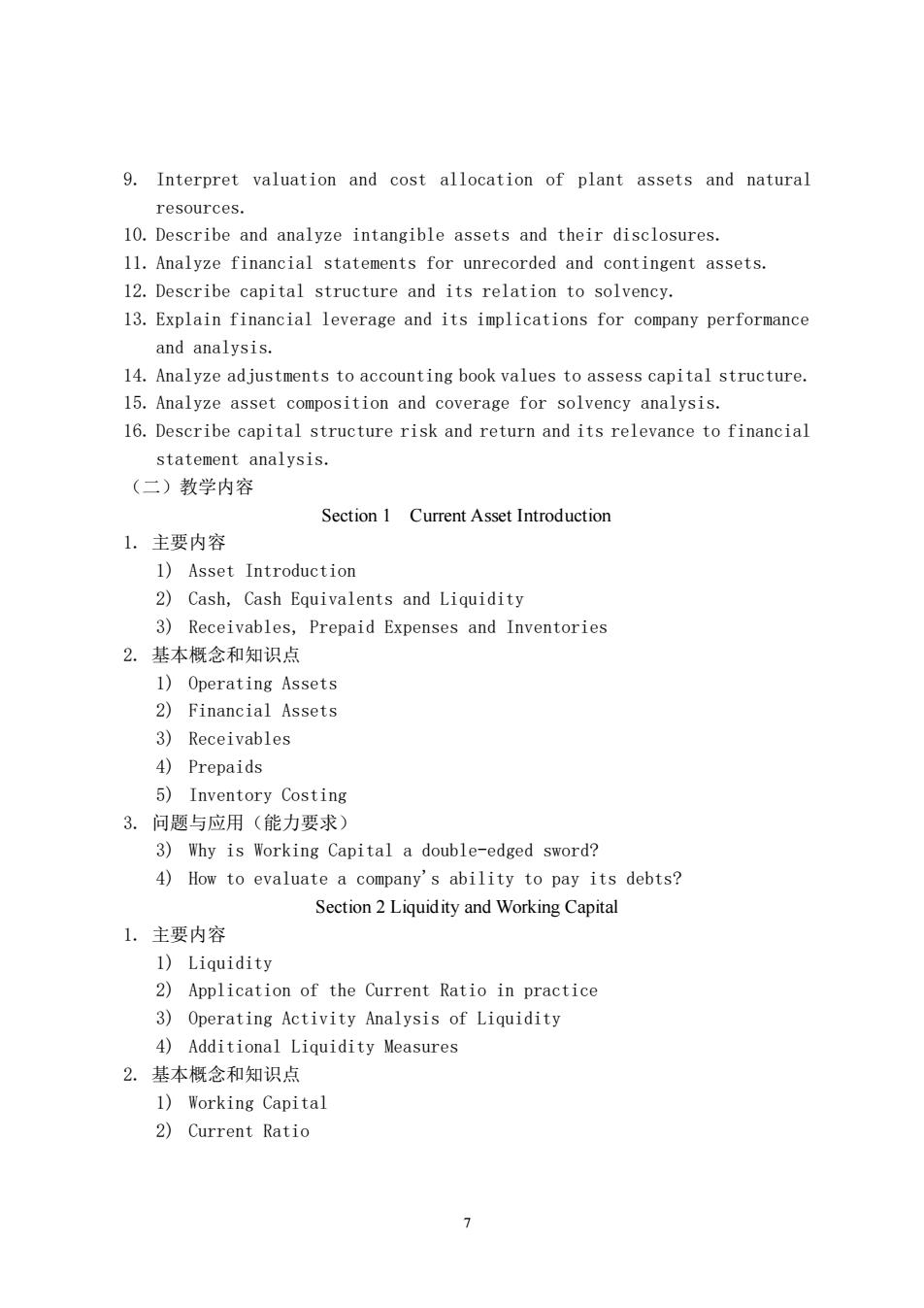
3)Components of Capital Stock 4)Basics of Retained Earnings 2.基本概念和知识点 1)Equity 2)Contributed capital 3)Treasury stock 4)Preferred stock 5)Common stock 6)Retained earnings 7)Cash and Stock Dividends 8)Other comprehensive income (loss) 9)Book value per share 3.问题与应用(能力要求) 1)How is Shareholders'Eguity analyzed? (三)思考与实践 1.Do you know the Financing Priority Theory?What are the priorities for corporates'financing activities? 2.What are the main debt risks of Chinese enterprises at present? (四)教学方法与手段 Multimedia teaching and Case discussion (五)课程思政融入点 1.Treat debt issues correctly and be wary of campus loans. Chapter3 Analyzing Investing Activities and Credit (一)目的与要求 1.Define current assets and their relevance for analysis. 2.Explain cash management and its implications for analysis. 3.Analyze receivables,allowances for bad debts,and securitization. 4.Interpret the effects of alternative inventory methods under varying business conditions. 5.Describe working capital measures of liquidity and their components. 6.Interpret the current ratio and cash-based measures of liquidity. 7.Analyze operating cycle and turnover measures of liquidity and their interpretation. 8.Explain the concept of long-lived assets and its implications for analysis. 6
6 3) Components of Capital Stock 4) Basics of Retained Earnings 2. 基本概念和知识点 1) Equity 2) Contributed capital 3) Treasury stock 4) Preferred stock 5) Common stock 6) Retained earnings 7) Cash and Stock Dividends 8) Other comprehensive income (loss) 9) Book value per share 3. 问题与应用(能力要求) 1) How is Shareholders’ Equity analyzed? (三)思考与实践 1. Do you know the Financing Priority Theory? What are the priorities for corporates’ financing activities? 2. What are the main debt risks of Chinese enterprises at present? (四)教学方法与手段 Multimedia teaching and Case discussion (五)课程思政融入点 1. Treat debt issues correctly and be wary of campus loans. Chapter3 Analyzing Investing Activities and Credit (一)目的与要求 1. Define current assets and their relevance for analysis. 2. Explain cash management and its implications for analysis. 3. Analyze receivables, allowances for bad debts, and securitization. 4. Interpret the effects of alternative inventory methods under varying business conditions. 5. Describe working capital measures of liquidity and their components. 6. Interpret the current ratio and cash-based measures of liquidity. 7. Analyze operating cycle and turnover measures of liquidity and their interpretation. 8. Explain the concept of long-lived assets and its implications for analysis

9.Interpret valuation and cost allocation of plant assets and natural resources. 10.Describe and analyze intangible assets and their disclosures. 11.Analyze financial statements for unrecorded and contingent assets 12.Describe capital structure and its relation to solvency. 13.Explain financial leverage and its implications for company performance and analysis. 14.Analyze adjustments to accounting book values to assess capital structure. 15.Analyze asset composition and coverage for solvency analysis. 16.Describe capital structure risk and return and its relevance to financial statement analysis. (二)教学内容 Section 1 Current Asset Introduction 1.主要内容 1)Asset Introduction 2)Cash,Cash Equivalents and Liquidity 3)Receivables,Prepaid Expenses and Inventories 2.基本概念和知识点 1)Operating Assets 2)Financial Assets 3)Receivables 4)Prepaids 5)Inventory Costing 3.问题与应用(能力要求) 3)Why is Working Capital a double-edged sword? 4)How to evaluate a company's ability to pay its debts? Section 2 Liquidity and Working Capital 1.主要内容 1)Liquidity 2)Application of the Current Ratio in practice 3)Operating Activity Analysis of Liquidity 4)Additional Liquidity Measures 2.基本概念和知识点 1)Working Capital 2)Current Ratio
7 9. Interpret valuation and cost allocation of plant assets and natural resources. 10. Describe and analyze intangible assets and their disclosures. 11. Analyze financial statements for unrecorded and contingent assets. 12. Describe capital structure and its relation to solvency. 13. Explain financial leverage and its implications for company performance and analysis. 14. Analyze adjustments to accounting book values to assess capital structure. 15. Analyze asset composition and coverage for solvency analysis. 16. Describe capital structure risk and return and its relevance to financial statement analysis. (二)教学内容 Section 1 Current Asset Introduction 1. 主要内容 1) Asset Introduction 2) Cash, Cash Equivalents and Liquidity 3) Receivables, Prepaid Expenses and Inventories 2. 基本概念和知识点 1) Operating Assets 2) Financial Assets 3) Receivables 4) Prepaids 5) Inventory Costing 3. 问题与应用(能力要求) 3) Why is Working Capital a double-edged sword? 4) How to evaluate a company's ability to pay its debts? Section 2 Liquidity and Working Capital 1. 主要内容 1) Liquidity 2) Application of the Current Ratio in practice 3) Operating Activity Analysis of Liquidity 4) Additional Liquidity Measures 2. 基本概念和知识点 1) Working Capital 2) Current Ratio